23/06/2025 to 26/06/2025
About My Project:
Right now, I’m working on a project to make a high-protein bar that is healthy, tasty, and made from natural Desi ingredients. Most protein bars in the market are expensive and have many unhealthy ingredients like artificial sugar, whey protein, emulsifiers, etc. These can be harmful if eaten regularly.
That’s why I decided to create a better, homemade option that gives good protein and energy using local, simple, and natural materials that are easily available around us.
What I Want to Achieve:
1.A 50 gm protein bar with 16–20 gm protein.
2.No chemicals, preservatives, or added sugar.
3.Easy to digest and good for all age groups—kids, youth, and old people.
4.Bar should be affordable and stay fresh for at least 1.5 to 2 months
Why Avoid Market Protein Bars:
I studied many famous brands like RiteBite, MuscleBlaze, YogaBar, and found they use:
Artificial sweeteners like Maltitol or sorbitol – cause gas and bloating.
Whey protein concentrate – some people feel heaviness and indigestion.
Emulsifiers and preservatives – not good for daily use.
Added sugars or corn syrup – bad for diabetics and long-term health.
That’s why I chose only safe, natural ingredients in my bar.

Why My Bar is Different:
A. Completely natural and homemade.
B. All Desi ingredients – no imported or synthetic items.
C. Easy to digest – no whey or soy.
D. No sugar – only Jaggery and maybe honey.
E. Budget-friendly – suitable for students, farmers, workers, and gym goers.
Why This Project is Important:
Today, people want healthy food, but most options are expensive or fake healthy. I want to make a real, nutritious bar that anyone can afford and trust. Our Indian food culture already has all the good ingredients—we just need to present them in a new form.
This project is helping me learn about food processing, nutrition, costing, and product development. I’m happy that I get to work on something which can be useful for society and has business potential to.
Ingredients I have Chosen:
| Ingredients | Reason behind using it |
| Moong dal flour | Easy to digest, full of protein |
| Chana (Besan) Flour | Desi protein, fiber, iron-rich |
| Yogurt Powder | Gives good taste and is a natural protein source |
| Roasted Peanuts | Gives crunch, healthy fats, and protein |
| Pumpkin Seeds | High in protein and good fats |
| Chia Seeds | Helps digestion, gives energy, fiber-rich |
| Watermelon Seeds | Tasty, adds minerals and protein |
| Coffee Beans (roasted) | For flavour and alertness (small amount) |
| Jaggery | Natural sweetener, full of iron |
| Honey (optional) | Good binder, gives shine and taste |
Nutritional Value Chart (per 100 gm of Ingredient) :
| Ingredient | Protein (g) | Fats (g) | Carbs (g) | Fiber (g) |
| Moong dal flour | 24 g | 1.3 g | 59.9 g | 8 g |
| Channa flour | 22 g | 6.7 g | 57.8 g | 10.8 g |
| Yogurt powder | 35 g | 1.5 g | 50 g | 0 g |
| Roasted peanuts | 25.8 g | 49.2 g | 16.1 g | 8.5 g |
| Chia seed | 17 g | 49 g | 10.7 g | 6 g |
| Pumpkin seed | 30 g | 31 g | 42 g | 34 g |
| Watermelon seeds | 28 g | 47.4 g | 15 g | 4 g |
| Coffee beans | 12 g | 14 g | 28 g | 4.8 g |
| Jaggery | 0.4 g | 0.1 g | 97 g | 0.6 g |
| Honey (optional ) | 0.3 g | 0 g | 82.4 g | 0.2 g |
Market Comparison (India – 2024–25 data)
| Brand | Bar size | Protein | MRP | Protein % |
| Max protein bar | 75 g | 20g | 90 rs | 26.6% |
| Yogabar | 60g | 10g | 50-55 rs | 16.6% |
| Muscleblaze bar | 70g | 22g | 99 rs | 31.4% |
| Ritebite bar | 50g | 10g | 50-60 rs | 20% |
| Our bar | 50g | Expected -16 g-20 g | Expected 50-60 rs | 32% |
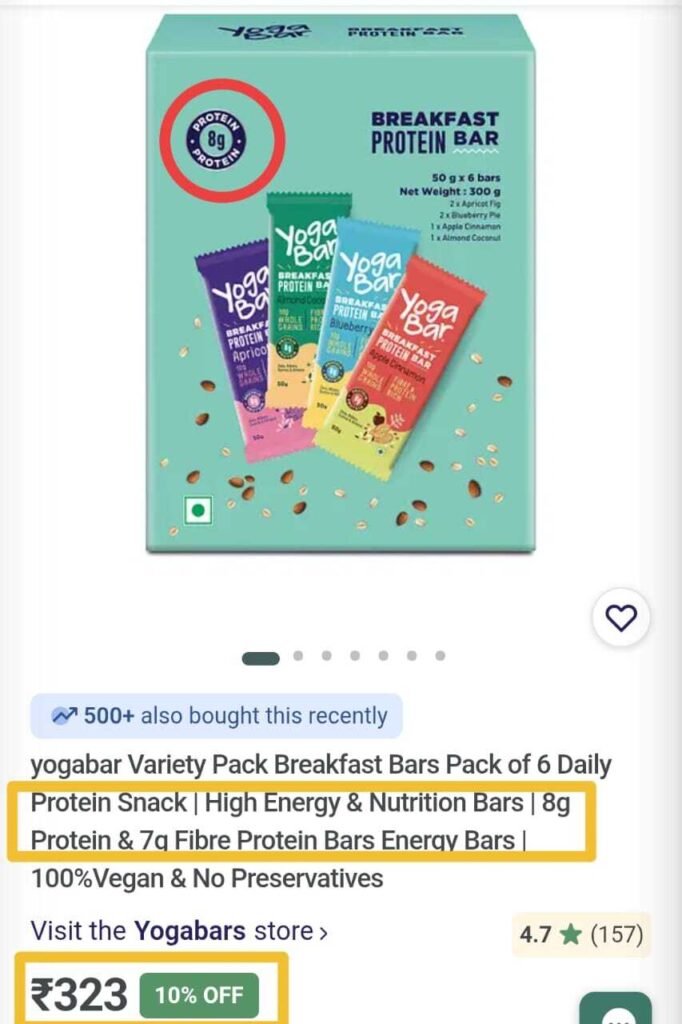
27/06/2025 to 28/06/2025
Ingredients quantity for 1 kg batch
| Ingredients | Quantity (gm) | Protein % | Protein (gm) |
| Moong Dal flour | 300 | 24 % | 72 |
| Chana flour | 150 | 22% | 33 |
| Yogurt powder | 100 | 35% | 35 |
| Rosted peanuts | 150 | 25.8% | 38.7 |
| Pumpkin seed | 100 | 30% | 30 |
| Chia seed | 50 | 17% | 8.5 |
| Watermelon seed | 50 | 28% | 14 |
| Rosted coffee beans | 30 | 12% | 3.6 |
| Jaggery | 80 | 0.4% | 0.3 |
| Honey | 20 | 0.3% | 0.06 |
30/06/2025 to 02/07/2025
Project Discussion: High-Protein Bar with Good Digestibility
On 30th June 2025, I had a valuable discussion with Mr.Dixit Sir regarding the formulation of my project: a high-protein nutrition bar. The focus of our conversation was to ensure that the bar contains 16–18 grams of protein, is easily digestible, affordable, and nutritionally balanced.
Key Takeaways from the Discussion
1.Prioritizing Ingredient Selection
We decided that selecting the right ingredients is the foundation of this project. Criteria include:
A. High protein content
B. Good digestibility
C. Affordable cost
D. Balanced in terms of fat, fiber, energy, and taste
2. Calculating Cost per Gram of Protein
We emphasized the importance of cost-efficiency. For each ingredient, I calculated:

This will help us estimate the total cost of protein per bar and optimize the overall production cost.
3.Discussion on Glycemic Index (GI)
A key part of our conversation focused on the Glycemic Index, which is critical in designing a health-focused protein bar.
🔬 What is GI?
The Glycemic Index (GI) is a measure of how quickly a food raises blood sugar after consumption.
The Glycemic Index (GI) is a value between 0 and 100 that tells you how quickly a carbohydrate-containing food raises blood glucose (sugar) levels after eating it.
| Foods are compared to pure glucose, which has a GI of 100. Low-GI foods digest slowly, giving steady energy. High-GI foods digest quickly, causing spikes in blood sugar. |
| GI RANGE | CLASSIFICATION | WHAT IT MEANS |
| 0-55 | Low GI | Best for stable energy and blood sugar |
| 56-69 | Medium GI | Moderate effect |
| 70+ | High GI | Rapid spike,fast energy crash |
Why GI Matters for Our Bar:
- Stable Energy: A low-GI bar provides long-lasting energy.
- Good Digestibility: Most low-GI foods are also slow-digesting and promote satiety.
- Better for All Age Groups: Ideal for diabetics, athletes, and health-conscious consumers.
- Avoids Sugar Crash: Helps maintain consistent blood glucose levels.
We aim to formulate our bar to have a GI between 30–55, which ensures:
1. Good digestibility
2. Sustained energy
3. Market competitiveness with premium bars in India
GI vs Digestibility
We also discussed that high GI ≠ high digestibility. Some foods digest quickly but spike blood sugar too much, which is not ideal. Our goal is to choose ingredients with high digestibility and low to moderate GI
04/07/2025 to 05/07/2025
Creating a Detailed Excel Sheet
I began developing a comprehensive Excel database containing:
- Ingredient names and categories
2. Nutritional values: protein, fat, carbohydrates, fiber
3. Digestibility level
4. Glycemic Index (GI)
5. Energy (kcal/100g)
6. Market price (Pune rates)
7. Price per gram of protein
This sheet will guide the ingredient selection process based on both nutritional and economic factors.
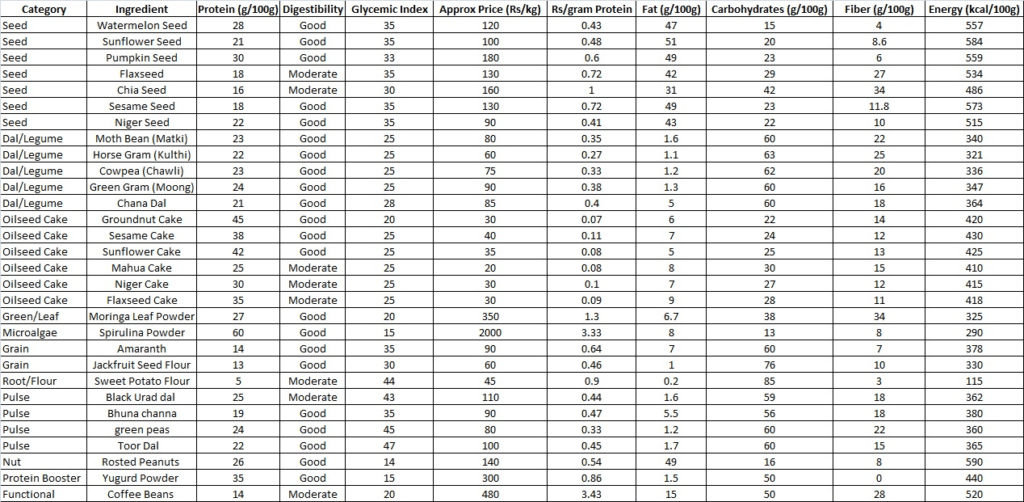
https://drive.google.com/file/d/1rmHNFtxCM_Dr57-Khi4b4kDKpMGpk0tV/view?usp=drivesdk
06/07/2025 to 10/07/2025
In meeting with Mr. Dixit sir , after study these ingredients they told me to make some compositions with these ingredients in which yoghurt powder , coffee beans ,jaggary these ingredients are fixed only three or four ingredients are get changed . According to that I make some compositions are as follows
Composition 1 – Groundnut cake +Spirulina + Chia
| Ingredients | Qty(g) | Price/ kg | Cost | GI | Digestibility |
| Defatted Groundnut Cake | 350 | 30 | 10.50 | 25 | Good |
| Spirulina Powder | 200 | 1200 | 240 | 10 | Good |
| Chia Seeds | 100 | 160 | 16 | 33 | Good |
| Yogurt Powder | 150 | 300 | 45 | 15 | Good |
| Coffee Beans | 20 | 480 | 9.60 | 20 | Moderate |
| Jaggery | 180 | 60 | 10.80 | 84 | Good |
| Totals | 1000 | 331.90 | |||
| Protein/bar | 17.43g | ||||
| Cost/bar | 8.30 rs | ||||
| Approx. GI | 35-40 |
Composition 2 – Bhuna chana + chana dal + pumpkin seed
| Ingredients | Qty(g) | Price/ kg | Cost | GI | Digestibility |
| Bhuna chana | 350 | 100 | 30 | 32 | Good |
| Chana dal | 200 | 85 | 17 | 28 | Good |
| Pumpkin seed | 150 | 180 | 27 | 33 | Good |
| Yogurt Powder | 150 | 300 | 45 | 15 | Good |
| Coffee Beans | 20 | 480 | 9.60 | 20 | Moderate |
| Jaggery | 180 | 60 | 10.80 | 84 | Good |
| Totals | 1000 | 139.40 | |||
| Protein/bar | 16.20g | ||||
| Cost/bar | 6.97 rs | ||||
| Approx. GI | 40-45 |
Composition 3 – Niger Cake +Cowpea + Spirulina
| Ingredients | Qty(g) | Price/ kg | Cost | GI | Digestibility |
| Niger Cake | 300 | 35 | 10.50 | 30 | Good |
| Cowpea | 200 | 95 | 20 | 31 | Good |
| Spirulina | 150 | 1200 | 180 | 10 | Good |
| Yogurt Powder | 150 | 300 | 45 | 15 | Good |
| Coffee Beans | 20 | 480 | 9.60 | 20 | Moderate |
| Jaggery | 180 | 60 | 10.80 | 84 | Good |
| Totals | 1000 | 274.90 | |||
| Protein/bar | 17.28g | ||||
| Cost/bar | 6.87 rs | ||||
| Approx. GI | 38-42 |
Composition 4 – Spirulina + Roasted peanuts + Amarnath
| Ingredients | Qty(g) | Price/ kg | Cost | GI | Digestibility |
| Spirulina | 250 | 1200 | 300 | 10 | Good |
| Roasted peaputs | 200 | 140 | 28 | 20 | Good |
| Amarnath | 150 | 90 | 14 | 35 | Good |
| Yogurt Powder | 150 | 300 | 45 | 15 | Good |
| Coffee Beans | 20 | 480 | 9.60 | 20 | Moderate |
| Jaggery | 180 | 60 | 10.80 | 84 | Good |
| Totals | 1000 | 407.90 | |||
| Protein/bar | 16.83g | ||||
| Cost/bar | 20.39 rs | ||||
| Approx. GI | 35-40 |
Composition 5 – Sesame cake + Matki + Sunflower seed
| Ingredients | Qty(g) | Price/ kg | Cost | GI | Digestibility |
| Sesame cake | 300 | 40 | 12.00 | 25 | Good |
| Matki | 200 | 85 | 17.00 | 30 | Good |
| Sunflower seed | 150 | 150 | 22.50 | 35 | Good |
| Yogurt Powder | 150 | 300 | 45 | 15 | Good |
| Coffee Beans | 20 | 480 | 9.60 | 20 | Moderate |
| Jaggery | 180 | 60 | 10.80 | 84 | Good |
| Totals | 1000 | 116.90 | |||
| Protein/bar | 15.02g | ||||
| Cost/bar | 5.85 rs | ||||
| Approx. GI | 35-40 |
Composition 6 – Add spirulina Boost
Composition 5 needs 1g more protein; you can add 30 g Spirulina replacing part of Jaggery.
Composition 7 – Black Urad dal + Chia seed +Flax seed
| Ingredients | Qty(g) | Price/ kg | Cost | GI | Digestibility |
| Black Urad dal | 300 | 90 | 27 | 43 | Moderate |
| Chia seed | 100 | 160 | 16.00 | 33 | Good |
| Flax seed | 100 | 130 | 13 | 35 | Moderate |
| Yogurt Powder | 150 | 300 | 45 | 15 | Good |
| Coffee Beans | 20 | 480 | 9.60 | 20 | Moderate |
| Jaggery | 180 | 60 | 10.80 | 84 | Good |
| Totals | 1000 | 121.40 | |||
| Protein/bar | 16.02g | ||||
| Cost/bar | 6.07rs | ||||
| Approx. GI | 35-40 |
Final summary with Digestibility of each bar
| Composition | Protein per bar | Cost per bar | Approx. GI | Overall digestibility |
| 1-Groundnut+Spirulina+Chia seed | 17.43 | 8.30 | 35-40 | Excellent |
| 2-Bhuna chann + pumpkin seed + Chana dal | 16.20 | 6.97 | 40-45 | Very good |
| 3-Niger cake+Cowpea+ Spirulina | 17.28 | 6.87 | 38-42 | Good |
| 4 -Spirulina +Amaranth + peanuts | 16.83 | 20.39 | 35-40 | Excellent |
| 5-Sesame cake +Matki + Sunflower seed | 15.02 | 5.85 | 35-42 | Very good |
| 6- Adjusted (with spirulina) | 16 (approx) | 7.21 | 40-45 | Moderate |
| 7-Black urad dal +Flax seed +chia seed | 16 | 6.07 | 35-40 | Very good |
Composition 8 – Kulthi + Spirilina + Amaranth +Coffee + Yogurt Powder +Date paste
| Ingredients | Qty(g) | Price/ kg | Cost | GI | Digestibility |
| Kulthi | 250 | 65 | 22.75 | 22 | Moderate |
| Spirulina | 150 | 1200 | 180 | 10 | Good |
| Amaranth | 200 | 90 | 18 | 35 | Moderate |
| Yogurt Powder | 150 | 300 | 45 | 15 | Good |
| Coffee Beans | 20 | 480 | 9.60 | 20 | Moderate |
| Date paste | 230 | 90 | 20.70 | 60 | Good |
| Totals | 1000 | 296.05 | |||
| Protein/bar | 17.02g | ||||
| Cost/bar | 7.40rs | ||||
| Approx. GI | 38-45 |
Composition 9 – Cowpea + Pumpkin seed + Niger seed cake +Coffee + Yogurt Powder + Jaggery
| Ingredients | Qty(g) | Price/ kg | Cost | GI | Digestibility |
| Cowpea | 250 | 95 | 23.75 | 32 | Moderate |
| Pumpkin seed | 200 | 180 | 36 | 33 | Good |
| Niger cake | 150 | 35 | 5.25 | 30 | Moderate |
| Yogurt Powder | 150 | 300 | 45 | 15 | Good |
| Coffee Beans | 20 | 480 | 9.60 | 20 | Moderate |
| Jaggery | 230 | 60 | 133.4 | 84 | Good |
| Totals | 1000 | ||||
| Protein/bar | 16.09g | ||||
| Cost/bar | 6.67 rs | ||||
| Approx. GI | 37-42 |
Composition 10 – Flax seed cake + Matki +Green Gram + Coffee + Yogurt Powder + Jaggery
| Ingredients | Qty(g) | Price/ kg | Cost | GI | Digestibility |
| Flax seed cake | 200 | 40 | 8 | 27 | Moderate |
| Matki | 200 | 85 | 17 | 30 | Good |
| Green gram | 200 | 100 | 20 | 28 | Moderate |
| Yogurt Powder | 150 | 300 | 45 | 15 | Good |
| Coffee Beans | 20 | 480 | 9.60 | 20 | Moderate |
| Jaggery | 230 | 60 | 13.80 | 84 | Good |
| Totals | 1000 | 113.4 | |||
| Protein/bar | 16.04g | ||||
| Cost/bar | 5.67 rs | ||||
| Approx. GI | 38-43 |
These are some compositions and along with that I have some another compositions with me do some issues like digestibility and costing I do not prefer them ,so after that I again went to dixit and they told to me two select any two compositions by myself and purchase required ingredients for the compositions . On 10/07/2025 I fix two compositions by myself and then purchases all required ingredients ,the compositions are as follows
A) Spirulina powder + rosted peanuts + Yoghurt powder+ watermelon seed + Flex seed +Jaggery + Coffee beans
B) Moong flour + channa flour + yogurt powder+Rosted peanuts + Pumpkin seed + Jaggery + coffee beans
11/07/20205 TO 12/07/2025
From 11/07/2025 I am starting the trials on these above compositions . Before starting actual trial I have to make a Yogurt powder and moong flour but for good digestibility sprout moong are best so I worked for that . Then Mr. Dixit sir told me that firstly do not dry yogurt directly in dryer add bhuna Chana flour in it and then dry it because when yogurt is get dried separately then microbial growth is get increased sometime so add other ingredient for reduce excessive moisture in it . After complete process with yogurt powder and moong flour I want to start actual trials on these protein bar.
13/07/2025
Process of making Yoghurt + Bhunna channa powder ( Futane)
- Boil milk and cool down
- After cooling add curd culture and place as it is for 6-8 hrs
- After setting yoghurt remove excessive water from it and add Bhuna Chana powder (250 gm )in it and mix throughout
- Spread on tray in the thin layer (using batter paper )
- Dry in electric dryer at 50-55 degree for approx 9-10 hrs
- After compete drying cool down it and remove dry matter and grind in mixture (I got 400 gm from 1200 gm total batter )
Process of making sprouted moong flour
- Sock the moong for approx 6-7 hrs
- After complete socking tight them in cloth for sprouting
- Place in cloth for 6-7 hrs for proper sprouting
- After complete sprouting cook them on iow flame for 20-25 min and place for cool down
- After cooking place them on tray add dry it for 2.30 – 3 hrs in dryer for 57 degree
- After complete drying grind them in mixture until achieve fine flour
14/07/2025
I conducted my first bar trial using:
Sprouted Moong Flour – 55 gm
Yogurt + Bhuna Chana Powder – 60 gm
Pumpkin Seeds – 18 gm
Roasted Peanuts – 40 gm
Jaggery – 100 gm (chikki jaggery)
The review of the trial was average — the taste was good, but the bar was too hard and chewy, and the texture was not ideal.
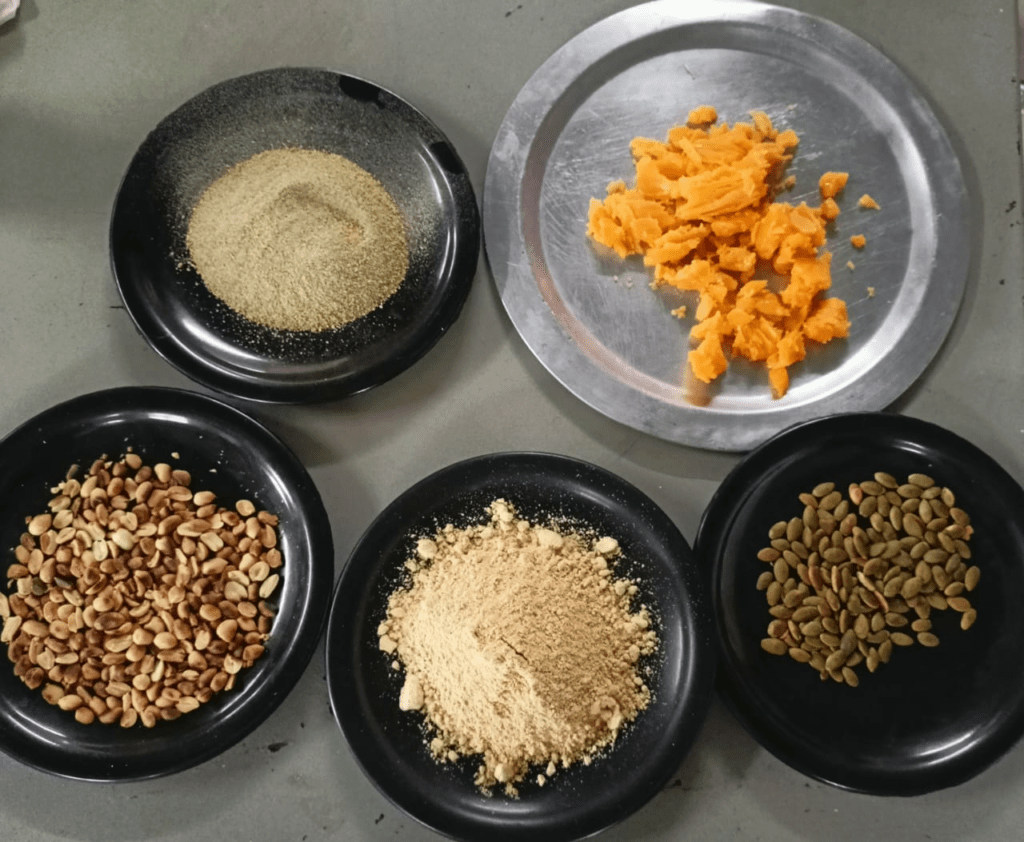
15/07/2025
I decided to conduct the second trial of my protein bar. I first worked on the ingredient proportions and initially tried using normal jaggery with a small quantity for binding, but it did not work effectively.
So, I revised the formulation and took another trial using chikki jaggery. The taste improved compared to the previous trial, but the texture was still too hard and chewy, making it difficult to eat.
I presented the bar to Dixit Sir, Prasad Sir, Abhijit Sir, and Mahesh Sir for review. They suggested:
1.Reducing the amount of jaggery
2.Using a hydraulic press for better binding and consistency
3.Researching alternative natural binders to improve texture
18/07/2025 to 19/07/2025
After discussion with Mr. Dixit sir I am decided to take various trial with different ingredients.
Ground the previously dried sprouted moong to prepare moong flour
Conducted two new trials of protein bars (50 gm each):
A. Using gum + jaggery as a binder
B. One using date paste as a binder
A. Using gum + jaggery as a binder
For these trial I am using following ingredients
Sprouted moong flour – 9 gm
Yoghurt + bhuna Chana powder- 9 gm
rosted peanuts – 5 gm
Pumpkin seed – 3 gm
Gond / Gum – 2 gm
graded jaggery -20 gm
Elahi – 1 gm
Mr. Dixit sir told me don’t make a bar during trial just make a small ball for observe texture and binding so I make a small ball from these batter .
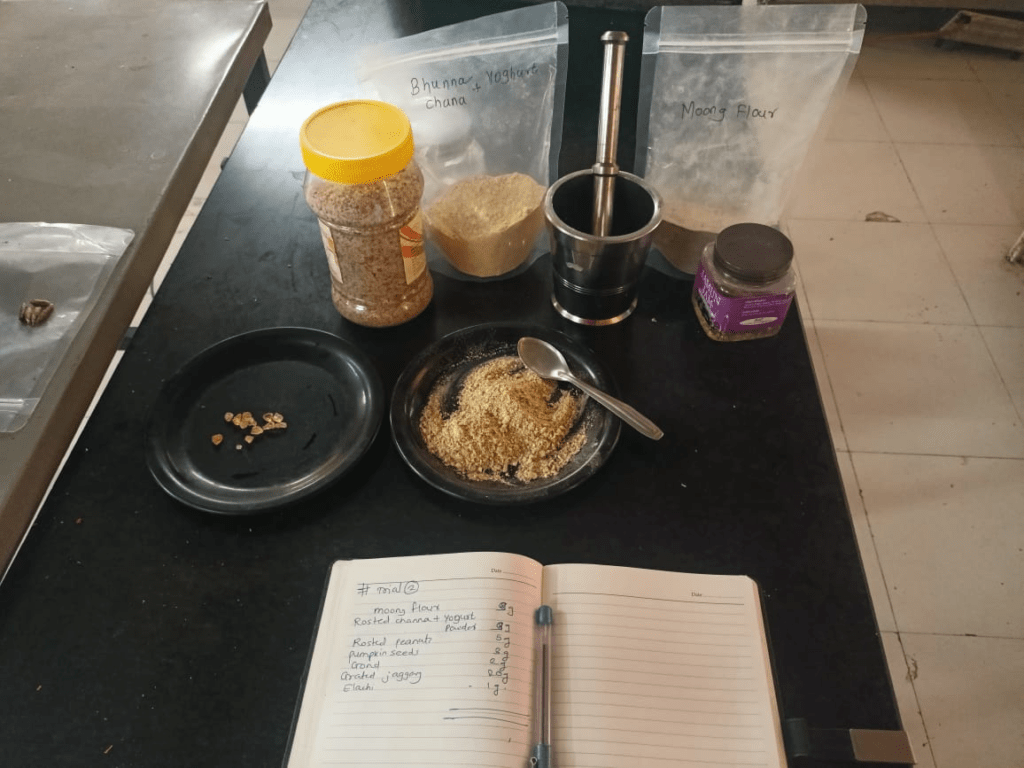
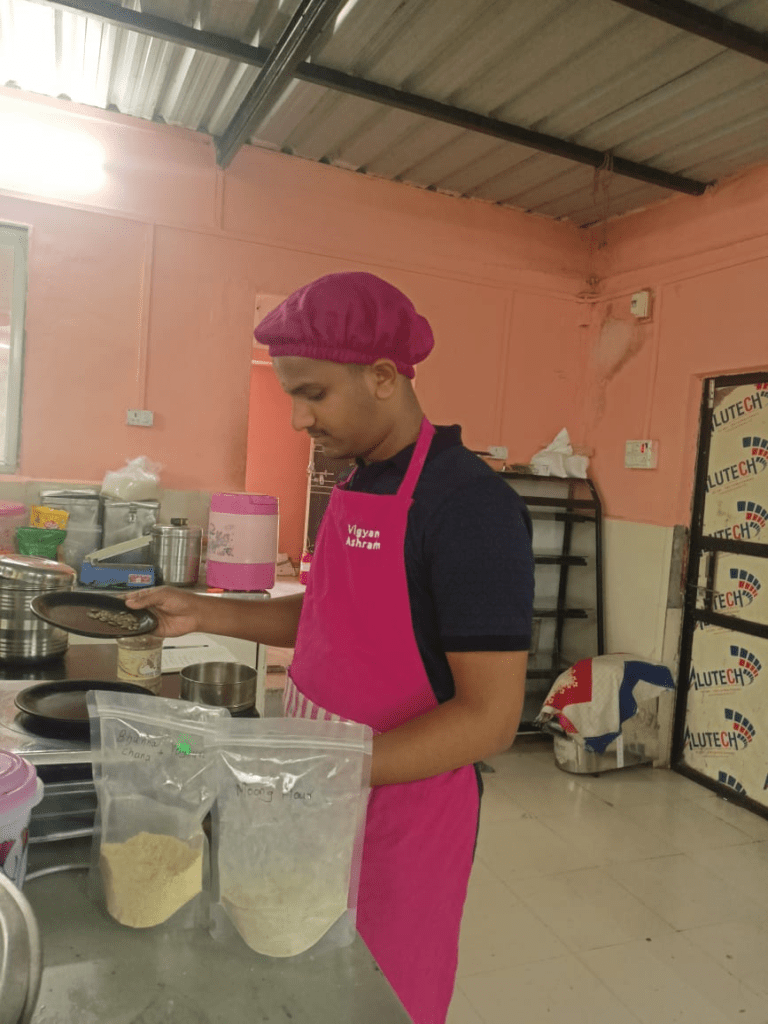
B. One using date paste as a binder
For these trial I am using following ingredients
Sprouted moong flour – 12 gm
Yoghurt + bhuna Chana powder- 12 gm
rosted peanuts – 8 gm
Pumpkin seed – 4 gm
Date paste -13 gm
Essence – 1 drop
From these batter also I make a small balls for observing texture and blinding
For reducing percentage of jaggery in bar hydraulic press is best option so I want to take a trial inside hydraulic press , currently hydraulic press is not available in Ashram so I am taking trial on bench vice and from these trial I got good textured bar .
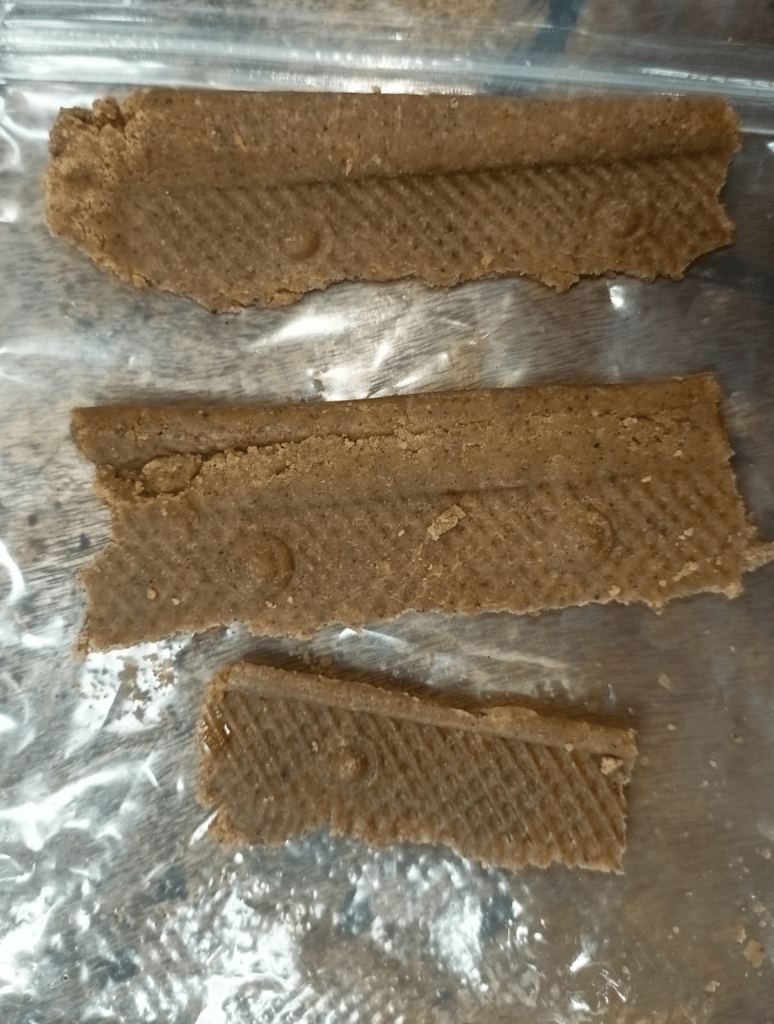
20/07/2025 to 22/07/2025
After taking these above trials I decided to reduce the jaggery percentage again up to 30% so composition for these is like
For these trial I am using following ingredients
Sprouted moong flour – 11 gm
Yoghurt + bhuna Chana powder- 11 gm
Rosted peanuts – 8 gm
Pumpkin seed – 5 gm
graded jaggery -15 gm
in these trial the I reduced the jaggery from 40% to 30 % and again discussed with Dixit sir they told me take another trial with combination of date paste and jaggery so I make a another composition with 5gm of date and 10 gm of jaggery so for these trial the composition is as flows
Date paste – 5 gm
Jaggery -10 gm
Sprouted moong flour – 11 gm
Yoghurt + bhuna Chana powder- 11 gm
Rosted peanuts – 8 gm
Pumpkin seed – 5 gm
these trial having also good results . and blinding is good with minimum blinder
23/07/2025 to 25/07/2025
My primary task was researching how to achieve proper binding using a minimal quantity of jaggery and dates so that the nutritional value of the bar can be improved. I explored different binding agents such as guar gum and glucose liquid, which can help in maintaining the desired texture and consistency.
Along with that I worked on searching high-protein ingredients that can provide a large protein boost with minimal quantity, without negatively affecting digestibility. During my research, I came across several options, but I found soybean to be a strong candidate. However, I noted that soy has digestibility challenges, and direct use of soy flour may impact the quality of my bar.
To address this, I explored methods to improve digestibility, including:
Roasting soy flour before use
Using sprouted soy flour
Fermenting soy flour
I discussed these options with Dixit sir, who advised me to attempt making sprouted soy flour, noting that sprouting soybeans is not an easy process.
01/08/2025 to 06/08/2025
So I decided to a trial with sprouted and fermented soy flour so step for these are as follows
Ingredients:
Whole soybeans (not flour)
Clean drinking water
Clean cloth or sprouting tray
Oven/dehydrator
Process:
- Soaking (Day 1)
Take 100 g dry soybeans → rinse well
Soak in 3x water for 8–10 hours (overnight)
- Sprouting (Day 2–3)
Drain water and rinse again
Wrap beans in moist cotton cloth or keep in a sprouting tray
Keep in warm place (not direct sunlight)
Let them sprout for 24–36 hours
Rinse once every 8–12 hours to prevent spoilage
Fermentation Procedure (Lactic Acid Type)
What You Need:
Sprouted soybeans – 100–500 g (as needed)
Starter culture – 1 tsp fresh curd (dahi) OR 1 probiotic capsule
Warm water – to make a thick paste
Glass/stainless steel bowl, cloth cover
step-by-Step process after sprouted soy beans achieve
- Grind Sprouted Soybeans
Grind the sprouted beans with minimal water into a thick paste
Keep it like idli batter consistency (not too watery)
- Add Starter Culture
Add 1 tsp curd or 1 probiotic capsule
Mix thoroughly
- Fermentation Time
Cover bowl with loose lid or cloth
Keep in warm place (30–35°C) for 12–16 hours
In winter, use oven with light on or wrap with towel
- Check for Readiness
You will see slight rise or bubbles
It will smell a bit sour (not rotten)
Soft, sticky texture — that’s ideal!
Make Fermented Soy Flour
- Spread fermented paste on tray (thin layer)
- Dry in dehydrator or hot air oven (55–60°C) for 6–8 hrs
- Grind to powder
- Store in airtight jar — ready-to-use fermented soy flour

Benefits of This Flour
1.High digestibility Great for gut, reduces gas
2.Enhanced protein use Improved amino acid absorption
3.Mild sour taste Enhances bar flavor subtly
4.Natural probiotics Supports gut health (if not heated too much)
So after achieving these sprouted fermented soy beans flour I take a trial with these. I total batter weight is 50 gm
Final Composition for One 50 g High-Protein Bar
Ingredient
Fermented Sprouted Soy Flour 15 g
Sprouted Moong Flour 10 g
Yoghurt + Bhuna Chana Powder 10 g
Roasted Peanuts 5 g
Pumpkin + Watermelon Seeds 4 g
Date Paste 5 g
Glucose Liquid 1 g
Total 50 g
Nutritional Output (per 50 g bar)
Nutrient Value
Protein 14.8 g
Fat 6.06 g
Carbs 20.81 g
Fiber 4.19 g
Calories ~220–230 kcal
08/08/2025
On the above composition I take a trial ,in these trial the results are as follows
- Blinding is good
- Overall texture is also good
- But due to fermentation process the ferment smell is occurs and some sour teast is also fill during eating

09/08/2025 to 12/08/2025
According to results , now my aim is to reduce the fermented smell from these fermented soy flour . Then I again discussed with Dixit sir about these then they told me to try with process like first ferment these flour then cook it for some time and then place it for drying in electrical dryer.
All process is same like above but just add cooking process in it ,and these cooking process is as follows
Cooking Process
Goal: Heat enough to reduce smell but not destroy too much protein quality.
- Moisture Adjustment:
If your fermented flour is moist or slightly lumpy, break up large clumps before cooking. Add 10–15% water (100–150 ml per 1 kg flour) to make even heating easier. - Heat Settings:
Gas stove / induction: Low to medium heat
Target temperature: 85–90°C inside the flour
(Use food thermometer if possible — above 90°C will cause unnecessary browning.)
- Cooking Time:
- Stir continuously to avoid burning at the bottom.
- 5–8 minutes is usually enough for smell reduction.
- You’ll notice smell shifting from sour to a mild, nutty aroma.
Again I achive these fermented cooked soy flour and now I have to take another trial with these flour .
Observation of smell from these flour is little bit sour smell is get redused then previous one
So I again take a trial with these fermented cooked flour and other ingredients composition / proportion is same
Final Composition for One 50 g High-Protein Bar with sprouted fermentated cooked soy flour
Ingredient
Fermented Sprouted cooked Soy Flour 15 g
Sprouted Moong Flour 10 g
Yoghurt + Bhuna Chana Powder 10 g
Roasted Peanuts 5 g
Pumpkin + Watermelon Seeds 4 g
Date Paste 5 g
Glucose Liquid 1 g
Total 50 g
Nutritional Output (per 50 g bar)
Nutrient Value
Protein 14.5 g
Fat 6.06 g
Carbs 20.81 g
Fiber 4.19 g
Calories ~220–230 kcal
Result of these trial is as follows
- Blinding is good but not that much perfect
- After cooking also sour teste is not change , it fills like eating acid content product
Also on 12/08/2025 on 9.00 pm we had a meeting with Tushar sir and Akit sir on topic – Fructo-oligosaccharide (FOS) and it can be used in our products and how many companies using these already
- What is Fructo-oligosaccharide (FOS)?
FOS is a prebiotic dietary fiber made of short chains of fructose molecules naturally found in foods like bananas, onions, garlic, and asparagus.
It’s slightly sweet (about 30-50% as sweet as sugar), but with very low calories because it’s not fully digested.
It acts as a food source for beneficial gut bacteria, promoting digestive health.
Often used as a sugar substitute or binding agent in food products, especially health-focused snacks.
- Benefits of Using FOS in Your Protein Bar
Benefit
Natural sweetener – Adds mild sweetness without adding much sugar or calories
Prebiotic fiber Supports gut health by promoting good bacteria
Improved binding – Helps hold ingredients together, improving texture
Low glycemic index – Good for blood sugar control, suitable for diabetic-friendly bars
Enhances moisture retention – Keeps bars moist and chewy without excess sugars
13/08/2025 to 14/08/2025
Now I have to work for reducing these excessive acid from these flour and I am searching for all possible ways to reduce the acidity in these flour after fermentation I disscused with Dixit sir about these also and the finial out for these is as follows
- I have to maintain acidity of the flour during fermentation – for that I have to reduce the fermentation time and also with maintain PH also . But according to Dixit sir guidliness , I am selected first option (reduce time of fermentation)
- Use of sodium bicarbonate at 0.2 % of flour weight .
Why Baking Soda Works
Fermentation produces organic acids (mainly lactic acid, acetic acid).
NaHCO₃ (baking soda) neutralizes these acids, releasing CO₂ (helps fluffiness) + water + sodium salts (less sour taste).
17/08/2025 to 18/08/2025
Now I am start to work on it and for that I sock another batch of 500 gm of soy beans and after sprouting , I make a paste of it and place for ferment with culture .
Now these time I redused the time of fermentation from 12-15 hrs to 5-6 hrs and also I am using sodium bicarbonate while cooking fermented soy flour .
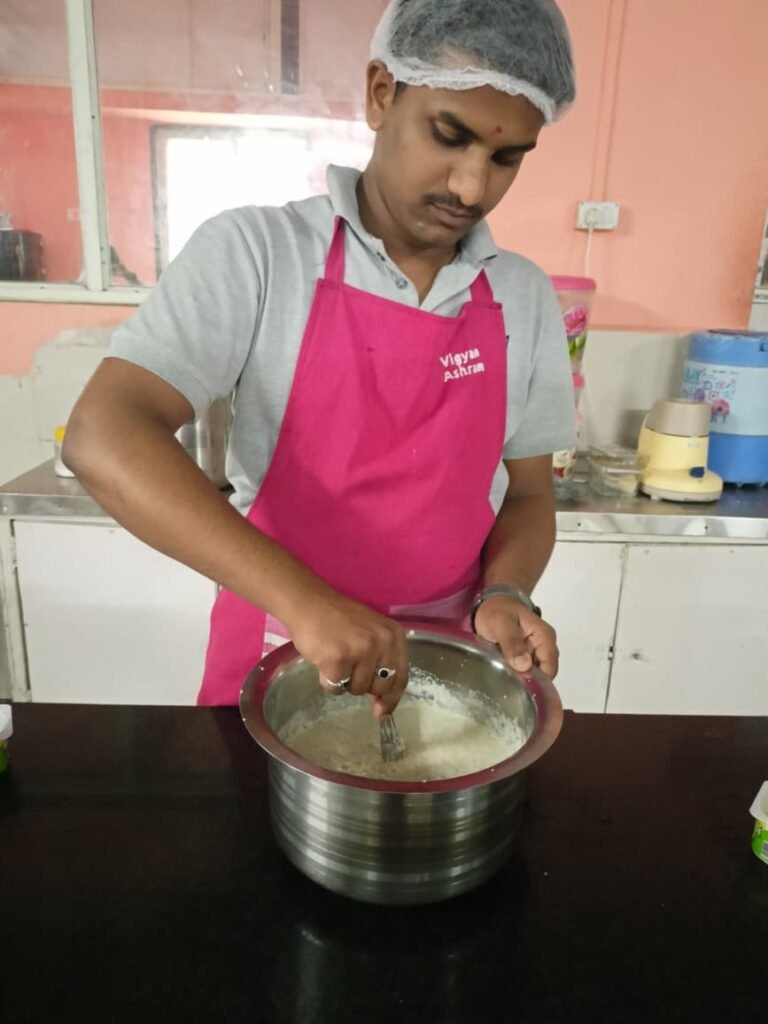
19/08/2025 To 20/08/2025
Now I reduced the time of fermentation from 12 hrs to 6 hrs and after as I said I have to add sodium bicarbonate , for these calculation I got 2 kg of fermented batter so
Typical Requirement
For fermented batters like dosa/idli or soy flour:
0.5 – 1% baking soda (w/w) is usually enough.
Above 1.5% gives a soapy/salty taste and can reduce protein digestibility.
Calculation for 2 kg (2000 g) Batter
0.5% → 10 g baking soda
1.0% → 20 g baking soda
So your safe range = 10–20 g sodium bicarbonate for 2 kg batter.
Practical Recommendation
Start with 12–15 g for 2 kg (≈ ¾ teaspoon per 500 g batter).
Mix well just before cooking/steaming, not earlier (otherwise gas escapes).
Do not exceed 20 g, otherwise taste and nutrition are affected.
So I used 14 gm of baking soda .
23/08/2025
After completing these treated soy flour I was taken a trial with these flour and other ingredients.
In these trial ingredients proportion is as follows
Treated fermented soy flour – 15 gm
Sprouted moong flour – 10 gm
Youghard + Bhuna chana powder – 10 gm
Roosted peanuts – 4 gm
Pumpkin seeds+ watermelon seed – 3 gm
Date paste – 5 gm
Glucose liquid – 3 gm
And nutritional values are as follows
Nutritional value chart
Energy – 191 kcl
Protein – 15 gm
Fat – 5.2 gm
Total carbohydrate – 22.4 gm

Result of these trial is as follows
- Blinding is good but not that much perfect ,I am using glucose liquid as blinding agent but still blinding is not proper .
12/09/2025
Binder Issue and Use of Ragi Flour
In our initial trials, I tried using glucose liquid as a binder, but the binding was not perfect. The bar was breaking apart and did not have proper shape stability. After discussing this challenge with Dixit sir, they guided me to use ragi flour as a natural binder. They suggested that the ragi flour should be cooked first, and then other ingredients can be mixed with it. This cooking step helps in activating the starch present in ragi, which improves stickiness and binding.
So I prepare the next trial batch using cooked ragi flour as the binder, and then add our protein-rich ingredients to form a compact and stable high-protein bar.
13/09/2025
Trial with Ragi Flour as Binder
I carried out a trial using ragi flour as the main binder, as per the guidance from Dixit sir. First, ragi flour was cooked to activate its starch, which improves stickiness and helps in binding. After that, the protein-rich ingredients (like moong dal flour, chana flour, yogurt powder, roasted peanuts, seeds, etc.) were added and mixed well.
The mixture was then pressed into a bar shape to check the binding strength, texture, and compactness. Compared to the earlier trial with glucose liquid, this method showed better binding and firmness.
Trial with Ragi Flour Binder – Ingredient Proportion
The following proportions of ingredients were used for the trial:
Treated fermented soy flour – 16 gm
Sprouted moong flour – 12 gm
Youghard + Bhuna chana powder – 10 gm
Roosted peanuts – 2 gm
Pumpkin seeds+ watermelon seed – 3 gm
Date paste – 2 gm
Ragi flour ( cooked ) – 5 gm
Nutritional value chart
Energy – 200 kcl
Protein – 15 gm
Fat – 4 gm
Total carbohydrate – 23 gm
Dietary fiber – 4 gm
Results – Trial 1 (Ragi Flour as Binder)
Binding: Good, the mixture held together well.
Texture: Not very smooth, slightly dry and powdery in nature.
Taste: Quite good, but needs improvement in sweetness and flavor.
Review (by Ranjeet sir): Binding is satisfactory, but overall texture should be improved. Additional sweetness and flavoring are required to make the bar more acceptable.
Trial with FOS-L55 as Binder
After completing the trial with ragi flour, I planned another trial using FOS-L55 as the binding agent. FOS-L55 is a prebiotic syrup that not only helps in binding the ingredients but also adds mild sweetness and improves gut health. It is widely used in functional foods due to its role in improving digestive health and providing dietary fiber.
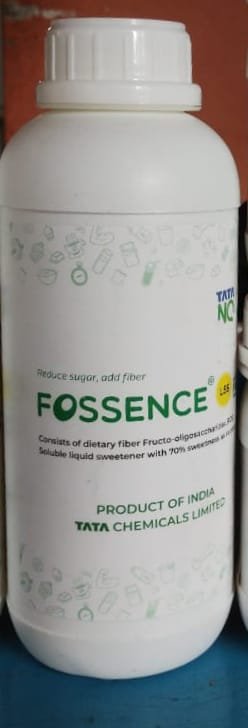
In this trial, FOS-L55 replaced ragi flour as the binder, while the remaining protein-rich ingredients (moong dal flour, chana flour, yogurt powder, roasted peanuts, pumpkin seeds, chia seeds, watermelon seeds, and flavoring) were kept in the same proportion.
The following proportions of ingredients were used for the trial:
Treated fermented soy flour – 16 gm
Sprouted moong flour – 12 gm
Youghard + Bhuna chana powder – 10 gm
Roosted peanuts – 2 gm
Pumpkin seeds+ watermelon seed – 3 gm
Date paste – 2 gm
FOS -L55 – 5 gm
Nutritional value chart
Energy – 188 kcl
Protein – 14.34 gm
Fat – 4.29 gm
Total carbohydrate – 18.81 gm
FOS fiber – 6.50 gm
Results – Trial 2 (FOS-L55 as Binder)
Binding: Very good, no extra effort required, ingredients blended easily.
Texture: Smooth and compact, not dry like in Trial 1.
Taste: Better compared to Trial 1, but still requires additional sweetness and flavoring for improved acceptance.
Review (by Ranjeet sir): Binding is satisfactory. Additional sweetness and flavoring are required to make the bar more acceptable.
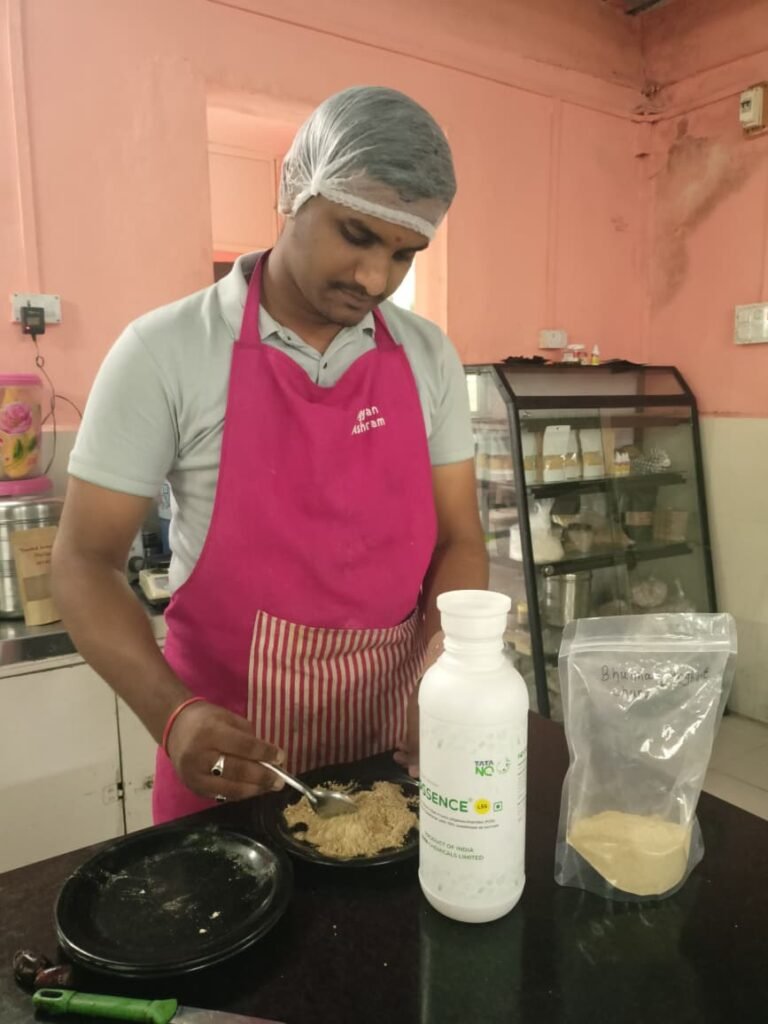
14/09/2025
Modified Composition for Taste Improvement
After feedback from earlier trials, I decided to make a slight change in the composition to improve the taste and sweetness of the protein bar. In this trial, jaggery powder was added along with FOS-L55 to enhance the flavor profile.
Ingredient Composition
Treated fermented soy flour – 23 g
Sprouted moong flour – 2 g
Yogurt + Bhunna chana powder – 12 g
Roasted peanuts – 2 g
Pumpkin seeds + Watermelon seeds – 2 g
Date paste – 2 g
FOS-L55 – 5 g
Jaggery powder – 2 g
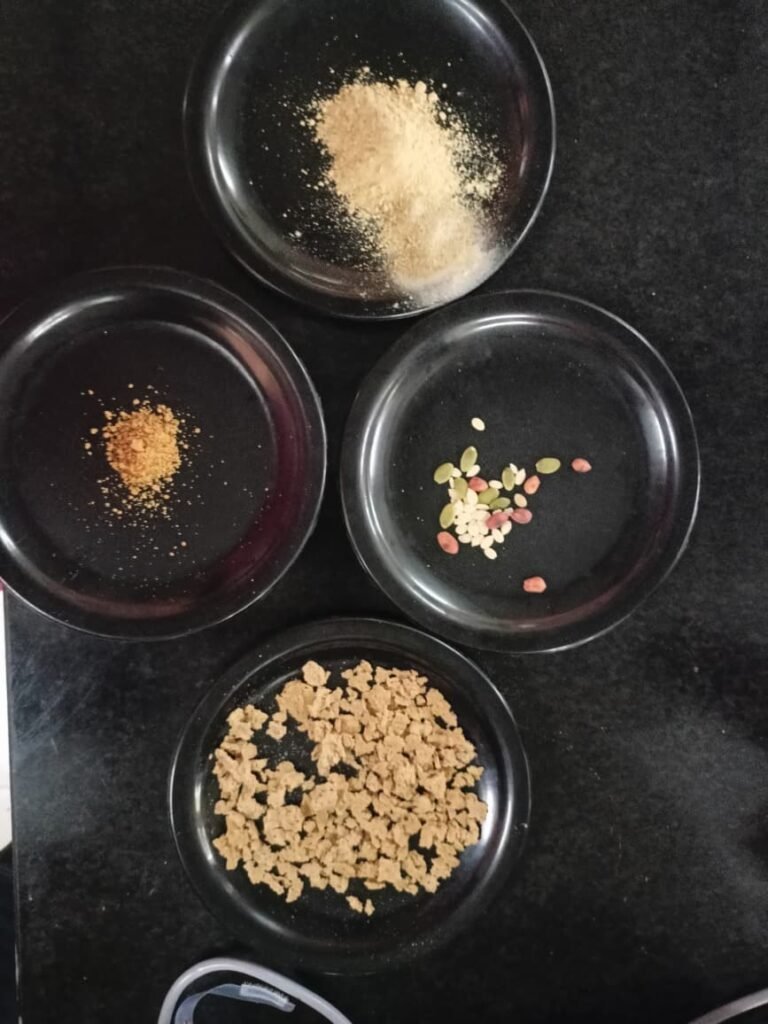
Nutritional Value (per bar):
Energy: 189 kcal
Protein: 14.89 g
Fat: 4.24 g
Total Carbohydrate: 17.23 g
Dietary Fiber: 4 g
Observation and Result
Binding was maintained with FOS-L55.
Texture remained smooth and compact.
Addition of jaggery powder improved sweetness and overall taste balance compared to earlier trials.
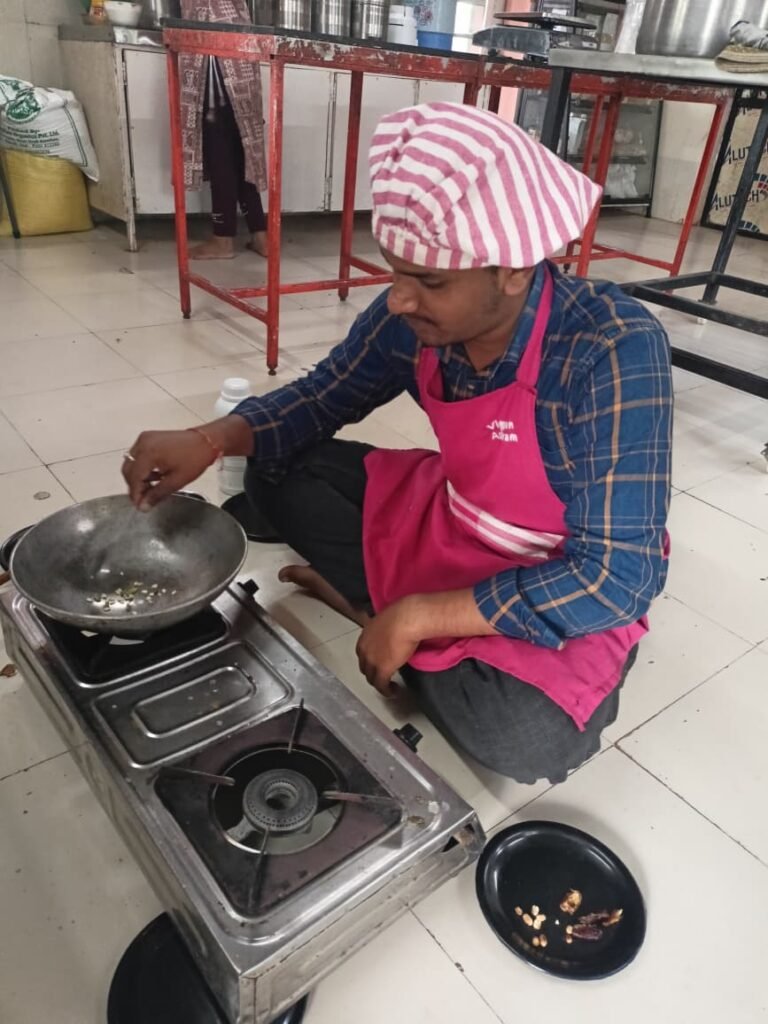
15/09/2025
Literature & Market Research
To further improve the binding and taste of my protein bar, I carried out background research on natural sweeteners, binders, and market products.
Stevia (Natural Sweetener):
- Zero-calorie natural sweetener extracted from Stevia leaves.
- Can be used to enhance sweetness without increasing calories.
- Needs careful dosage as excess stevia may give a bitter aftertaste.
Market Research – Yoga bar:
- Studied ingredients used in Yoga bar protein bars, which include whey protein isolate, oats, nuts, dates, seeds, and natural sweeteners.
- Noted that their binding agents are mostly natural syrups (honey, dates) and sometimes soluble fibers.
- Gained insight into how commercial brands balance taste + nutrition + texture.
FOS (Fructo-oligosaccharide):
- Found that FOS is considered safe as a prebiotic ingredient.
- General recommended intake for humans is around 5–15 g per day (can vary depending on tolerance).
- Using 5 g per bar is within a safe and beneficial range.
Palm Jaggery:
- A natural sweetener rich in minerals and antioxidants.
- Provides a unique caramel-like flavor.
- Can be explored as an alternative to jaggery powder for better taste and nutrition.
16/09/2025
Designing New Trials for Taste & Binding
Based on the research and feedback from earlier trials, I planned Two different variations to improve sweetness, flavor, and binding in the protein bar:
Planned Variations:
A. Honey – to act as a natural sweetener and binder.
B. Different Types of Dates – selected stickier and sweeter varieties compared to the earlier trial, to naturally improve both binding and sweetness.
Trials Conducted:
On this day, I carried out two trials among the above options:
Trial no 01 – Honey – 2gm and Dates – 2 gm
Ingredient Composition
Treated fermented soy flour – 23 g
Yogurt + Bhuna chana powder – 14 g
Roasted peanuts – 2 g
Pumpkin seeds + Watermelon seeds – 2 g
Date paste – 2 g
FOS-L55 – 5 g
Honey – 2 g

Nutritional Value (per bar):
Energy: 191 kcal
Protein: 15.09 g
Fat: 4.24 g
Total Carbohydrate: 17.23 g
Dietary Fiber: 4.33 g
Observation and Result
Binding was maintained with FOS-L55.
Texture remained smooth and compact.
Addition of Honey improved sweetness but no as expected and overall taste balance compared to earlier trials.
Trial no – 02 – 4 gm of different types of dates
Ingredient Composition
Treated fermented soy flour – 23 g
Yogurt + Bhuna chana powder – 14 g
Roasted peanuts – 2 g
Pumpkin seeds + Watermelon seeds – 2 g
New type of Date paste – 4 g
FOS-L55 – 5 g
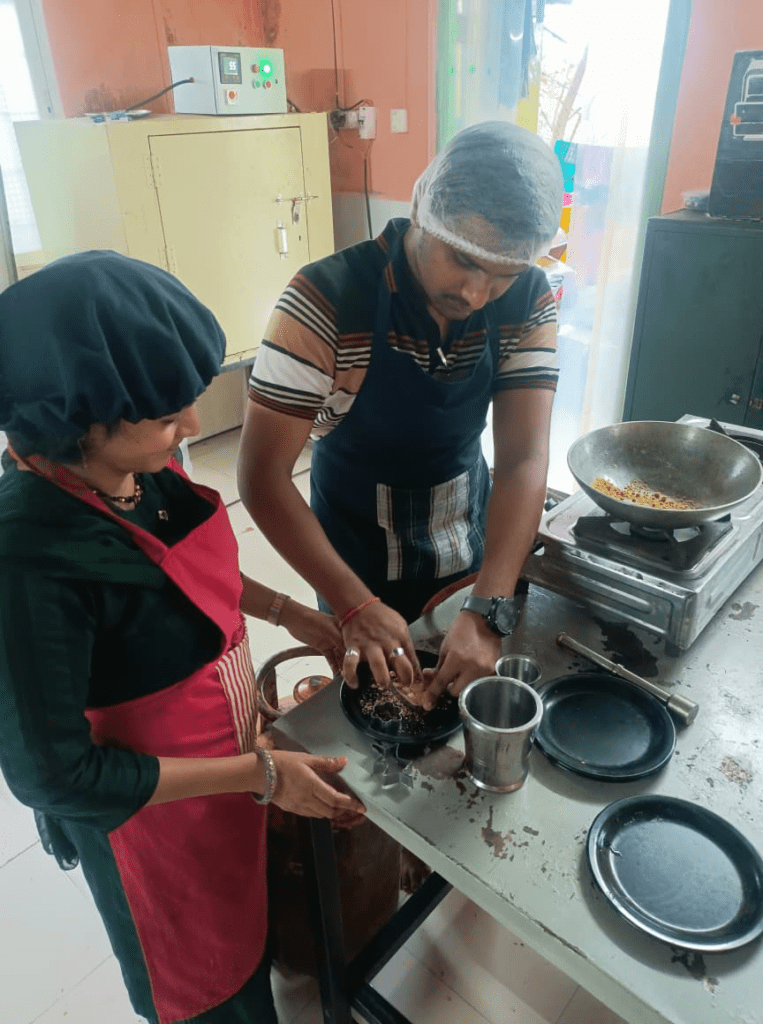
Nutritional Value (per bar):
Energy: 191 kcal
Protein: 14.80 g
Fat: 4.34 g
Total Carbohydrate: 17.02 g
Dietary Fiber: 6.31 g
Observation and Result
Binding was maintained with FOS-L55 and dates its getting difficult to mold
Texture remained smooth and compact.
Addition of new type of dates improved sweetness but no as expected and overall taste balance compared to earlier trials.
17/09/2025
I already take trials with different dates and half honey means only 2 gm of dates , then I decided to take a another trial with complete honey means 4 gm of honey .
Trial no – 03 – 4 gm of Honey
Ingredient Composition
Treated fermented soy flour – 23 g
Yogurt + Bhuna chana powder – 14 g
Roasted peanuts – 2 g
Pumpkin seeds + Watermelon seeds – 2 g
Honey – 4 g
FOS-L55 – 5 g
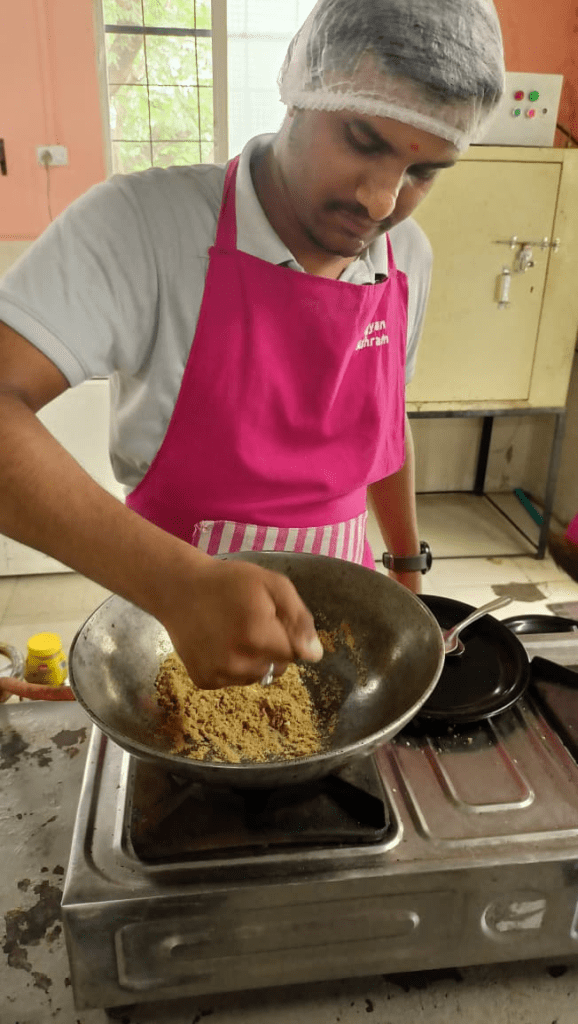
Nutritional Value (per bar):
Energy: 191 kcal
Protein: 14 g
Fat: 4.29 g
Total Carbohydrate: 17.32 g
Dietary Fiber: 6.31 g
Observation and Result
Binding was not maintained without date paste and in present of honey
19/09/2025
Again I discussed with Dixit sir about how can we solve the problem of binding so they suggest me take another trial with cooked ragi flour but these time make sure that the flour is clean and sieved for achieving smooth texture, they give me various options like ragi flour , rise flour , wheat flour so I take a two trials .
A – Cooked ragi flour as binder
B – गव्हाचा सत्व (Wheat Extract/Starch) as Binder
Trial Details
- Ragi Flour (Cooked) as Binder
Process: Ragi flour was cooked to activate starch and then mixed with protein-rich ingredients.
Ingredient Composition
Treated fermented soy flour – 18 g
Sprouted moong flour – 10 g
Yogurt + Bhuna chana powder – 12 g
Roasted peanuts – 2 g
Pumpkin seeds + Watermelon seeds – 2 g
Cooked ragi flour – 6 g
FOS-L55 – 5 g
Jaggery – 3 g
Nutritional Value (per bar):
Energy: 217.7 kcal
Protein: 15.58 g
Fat: 4.18 g
Total Carbohydrate: 24.32 g
Dietary Fiber: 6.45 g
Observation and Result
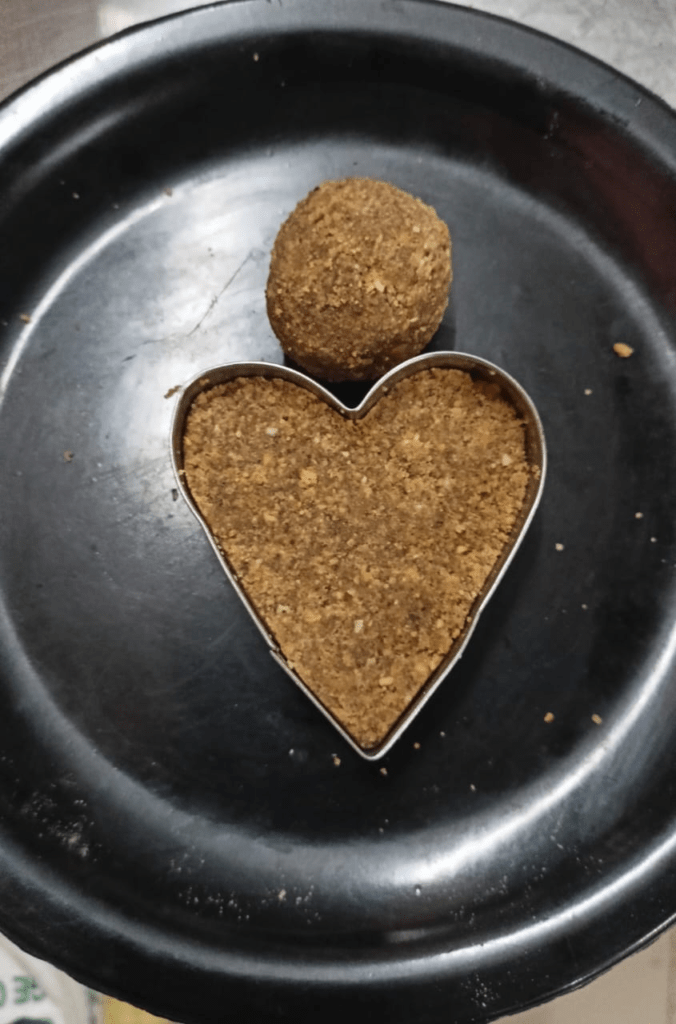
2. गव्हाचा सत्व (Wheat Extract/Starch) as Binder
Process: गव्हाचा सत्व (Wheat Extract/Starch) flour was cooked to activate starch and then mixed with protein-rich ingredients.
Ingredient Composition
Treated fermented soy flour – 18 g
Sprouted moong flour – 10 g
Yogurt + Bhuna chana powder – 12 g
Roasted peanuts – 2 g
Pumpkin seeds + Watermelon seeds – 2 g
गव्हाचा सत्व (Wheat Extract/Starch) flour – 6 g
FOS-L55 – 5 g
Jaggery – 3 g
Nutritional Value (per bar):
Energy: 219.7 kcal
Protein: 15.8 g
Fat: 4.21 g
Total Carbohydrate: 24.52 g
Dietary Fiber: 6.47 g
Observation and Result
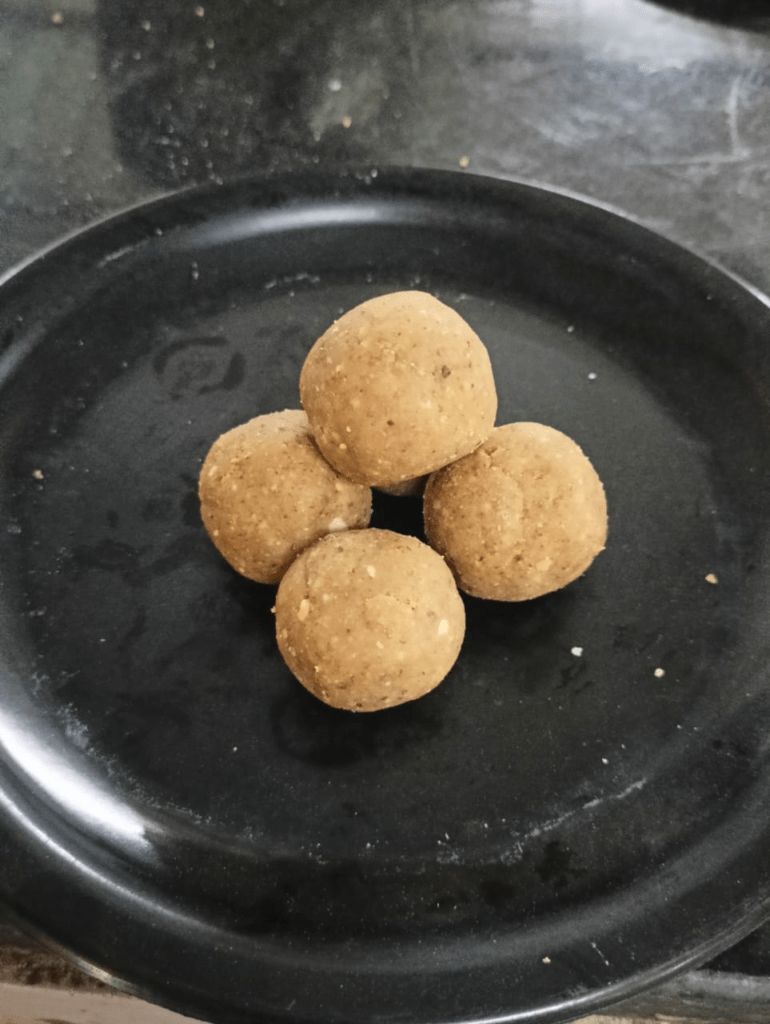
20/09/2025
Discussion and Next Trial Plan
Today I discussed the results of the last two trials (Ragi flour and गव्हाचा सत्व as binders). During the review session, we focused on consumer preferences and how to make the bar more acceptable in terms of taste, sweetness, and binding.
Key Discussion Points
- People generally prefer bars that are slightly sweeter, chewy, and soft in texture.
- Current formulations need improved sweetness and a smoother bite.
- Binding should be strong but not make the bar too dry or hard.
Guidance Received
Based on these points, the following changes were suggested for upcoming trials:
- Increase the percentage of jaggery – to improve natural sweetness, flavor, and mouthfeel.
- Increase FOS-L55 quantity – to strengthen binding, improve chewiness, and add prebiotic value.
- If binding does not occur properly, then we will consider using cooked ragi flour again in combination with the above ingredients.
Next Step
I will design and carry out the next set of trials by adjusting the jaggery and FOS-L55 levels, while monitoring their effects on:
- Binding strength
- Texture (smoothness, chewiness)
- Taste (sweetness, flavor balance)
- Nutritional value
24/09/2025
Protein Bar Trial with Jaggery & FOS Adjustment
As per the previous discussion, I conducted a new trial on 24th September 2025 with two main variations:
- Increased jaggery percentage
- Increased FOS-L55 level
The objective was to improve sweetness, binding, and consumer acceptability while maintaining nutritional balance.
Ingredient Composition
Treated fermented soy flour – 18 g
Sprouted moong flour – 10 g
Yogurt + Bhuna chana powder – 12 g
Roasted peanuts – 2 g
Pumpkin seeds + Watermelon seeds – 2 g
FOS-L55 – 6 g
Jaggery – 10 g
Nutritional Value (per bar):
Energy: 225.57 kcal
Protein: 15.18 g
Fat: 4.21 g
Total Carbohydrate: 27.12 g
Dietary Fiber: 6.75 g
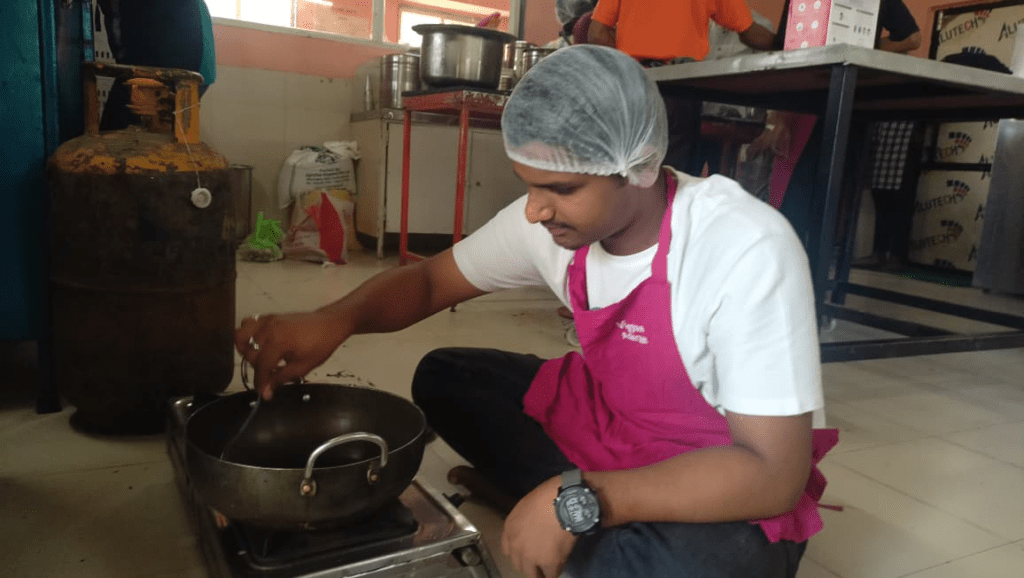
26/09/2025
Protein Bar Trial with Haliv (Garden Cress Seeds)
On 26th September 2025, I decided to take a trial independently.
The main focus was to improve the “flourly” dry texture that was felt after chewing the bar in earlier trials.
To address this issue, I experimented with Haliv (Garden cress seeds) because:
Haliv is naturally rich in protein, iron, and omega-3 fatty acids.
When soaked/cooked, it produces a gel-like consistency that can work as a natural binder.
It also improves mouthfeel and helps in reducing the “powdery” sensation after eating.
Key Objective
- Improve texture smoothness.
- Increase binding naturally.
- Add nutritional value without artificial binders.
Ingredient Composition
Treated fermented soy flour – 18 g
Sprouted moong flour – 10 g
Yogurt + Bhuna chana powder – 12 g
Roasted peanuts – 2 g
Pumpkin seeds + Watermelon seeds – 2 g
FOS-L55 – 6 g
Jaggery – 10 g
Haliv (Garden Cress Seeds)– 2 gm
Nutritional Value (per bar):
Energy: 220.57 kcal
Protein: 15.8 g
Fat: 4.22 g
Total Carbohydrate: 26.12 g
Dietary Fiber: 6.75 g
Observation and Result
Binding was maintained with FOS-L55 and jaggery
Texture remained smooth and compact.
Addition of jaggery improved sweetness but no as expected and overall taste balance compared to earlier trials. And haliv help to create moisture in flours but still we facing problems like floury texture
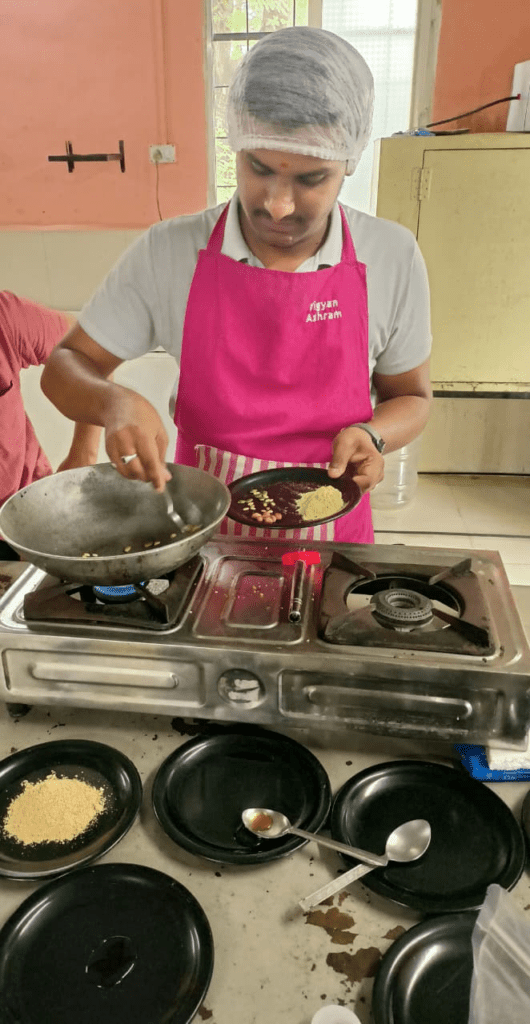
27/09/2025
Discussion with Dixit Sir on Taste & Texture Improvement
On 27th September 2025, I discussed the outcomes of my recent trials with Dixit Sir.
The key issues identified were:
- Taste is still missing – despite good protein content and binding improvements.
- Dry / floury texture after eating – the bar still feels powdery in the mouth.
Discussion Output & Guidance
Sir suggested that to overcome these challenges, we need to:
- Introduce fat sources like ghee or oil into the flour mixture.
- The addition of ghee/oil will:
- Improve mouthfeel and reduce dryness.
- Enhance flavor profile (richer taste).
- Provide better texture cohesion by coating flour particles.
Next Step
👉 In the upcoming trials, I will incorporate ghee or oil during flour mixing.
👉 The aim is to achieve:
- Improved taste
- Softer, non-dry texture
- More consumer-friendly bar
28/09/2025
Protein Bar Trials with Jaggery & Ghee
I carried out two important trials to address taste and texture challenges from previous versions.
Trial 1 – Increased Jaggery
Objective: Improve sweetness, natural binding, and consumer appeal.
Ingredient Composition
Treated fermented soy flour – 18 g
Sprouted moong flour – 10 g
Yogurt + Bhuna chana powder – 12 g
Roasted peanuts – 2 g
Pumpkin seeds + Watermelon seeds – 2 g
FOS-L55 – 6 g
Jaggery – 15 g
Nutritional Value (per bar):
Energy: 188.57 kcal
Protein: 15.9 g
Fat: 3.22 g
Total Carbohydrate: 24.63 g
Dietary Fiber: 5.22 g
Observation and Result
Binding was maintained with FOS-L55 and jaggery
Texture remained smooth and compact.
Overall trials results also good .
Trial 2 – Increased Jaggery and add ghee also
during these I decided to take trial with ghee and also in these trial I don’t take a melted jaggery, I mix these jaggery in mixture
Objective: Reduce dryness / floury texture and enhance taste.
Ingredient Composition
Treated fermented soy flour – 18 g
Sprouted moong flour – 10 g
Yogurt + Bhuna chana powder – 12 g
Roasted peanuts – 2 g
Pumpkin seeds + Watermelon seeds – 2 g
FOS-L55 – 6 g
Jaggery – 15 g
Ghee – 20 gm
Nutritional Value (per bar):
Energy: 198.57 kcal
Protein: 14.9 g
Fat: 5.22 g
Total Carbohydrate: 28.63 g
Dietary Fiber: 6.22 g
Observation and Result
- Binding was perfect
- Taste is good
- Overall result is good and good response
Reason for Change from Protein Bar to Protein Ball
Initially, the main aim of my project was to develop a high-protein energy bar using natural ingredients and to provide both nutrition and taste. During the course of multiple trials, I observed several challenges in achieving the desired binding, texture, and moisture level in the bar form. Despite increasing jaggery percentage and experimenting with ingredients like FOS-L55 and ragi flour for better binding, the bar often became either too dry or too hard, affecting its mouthfeel and consumer acceptability.
After continuous discussions with Dixit sir and based on sensory evaluation feedback, we realized that the same formulation could achieve a better texture and taste if converted into a protein ball form. The round shape allowed for easier molding, better ingredient mixing, and improved chewiness, maintaining both the nutritional value and the appealing taste. Additionally, the protein ball format required less effort in cutting, shaping, and packaging, making it more feasible for large-scale production and exhibition display.
Hence, after detailed analysis and experimentation, I decided to finalize my project as a High-Protein Energy Ball instead of a bar. This change not only improved the overall taste, texture, and consumer appeal but also aligned better with the project’s goals of creating a nutritious, affordable, and easily consumable product suitable for all age groups.
29/09/2025
Finalized Trial and Batch Preparation for Exhibition
After a series of continuous experiments and guidance from Dixit Sir, I finally decided to fix my last successful trial formulation as the final version of my protein bar.
The objective now was to prepare a larger batch for product showcasing at an exhibition held in Pune.
Key Highlights from Finalized Trial
- Binder: Combination of FOS-L55, Jaggery, and a small amount of Ghee.
- Reason for Fixation:
- Excellent binding stability.
- Smooth and soft texture (no dry or flourly feel).
- Improved taste and natural sweetness.
- Overall balanced nutritional composition.
30/09/2025
Large Batch Preparation
To meet exhibition requirements, I scaled up the ingredients proportionally based on my 50 g bar formula.
I calculated the total flour and ingredient quantity needed for the large batch to ensure consistent texture and taste across all samples.
- Your last successful trial batch = 80 g total
- You want a large batch = ~1000 g (1 kg)
- To know the scaling factor:
Scaling factor=100080=12.5\text{Scaling factor} = \frac{1000}{80} = 12.5Scaling factor=801000=12.5
That means — if you multiply each ingredient in your 80 g formula by 12.5, you’ll get ~1000 g batch.
| Ingredient | Amount (g) | % of total (80 g) |
|---|---|---|
| Soy flour | 18 | 22.5% |
| Yog+Chana powder | 12 | 15.0% |
| Sprouted moong flour | 10 | 12.5% |
| Roasted peanuts | 2 | 2.5% |
| Mixed seeds | 2 | 2.5% |
| FOS-L55 | 6 | 7.5% |
| Jaggery | 15 | 18.8% |
| Ghee | 15 | 18.8% |
| Total | 80 g | 100% |
Scale-up examples
(A) ~1 kg batch (multiply ×12.5)
- Soy flour: 18 × 12.5 = 225 g
- Yogurt +Channa powder : 12 × 12.5 = 150 g
- Moong flour: 10 × 12.5 = 125 g
- Peanuts: 2 × 12.5 = 25 g
- Seeds: 2 × 12.5 = 25 g
- FOS-L55: 6 × 12.5 = 75 g
- Jaggery: 15 × 12.5 = 187.5 g
- Ghee: 15 × 12.5 = 187.5 g
Total ≈ 1000 g
01/10/2025 to 04/10/2025
Final Preparation, Costing & Packaging Work
After finalizing the successful formulation on 29th September 2025, I started working on the final production and commercialization phase of my protein bar project.
During this period, my focus shifted from trials to practical preparation and marketing aspects.
1. Flour Preparation
- Prepared all flours in the required quantities for the large batch:
- Treated fermented soy flour
- Sprouted moong flour
- Yogurt + Bhunna chana powder mixture
- Seed mixture (pumpkin + watermelon)
- Ensured uniform texture, proper roasting, and storage for maintaining quality.
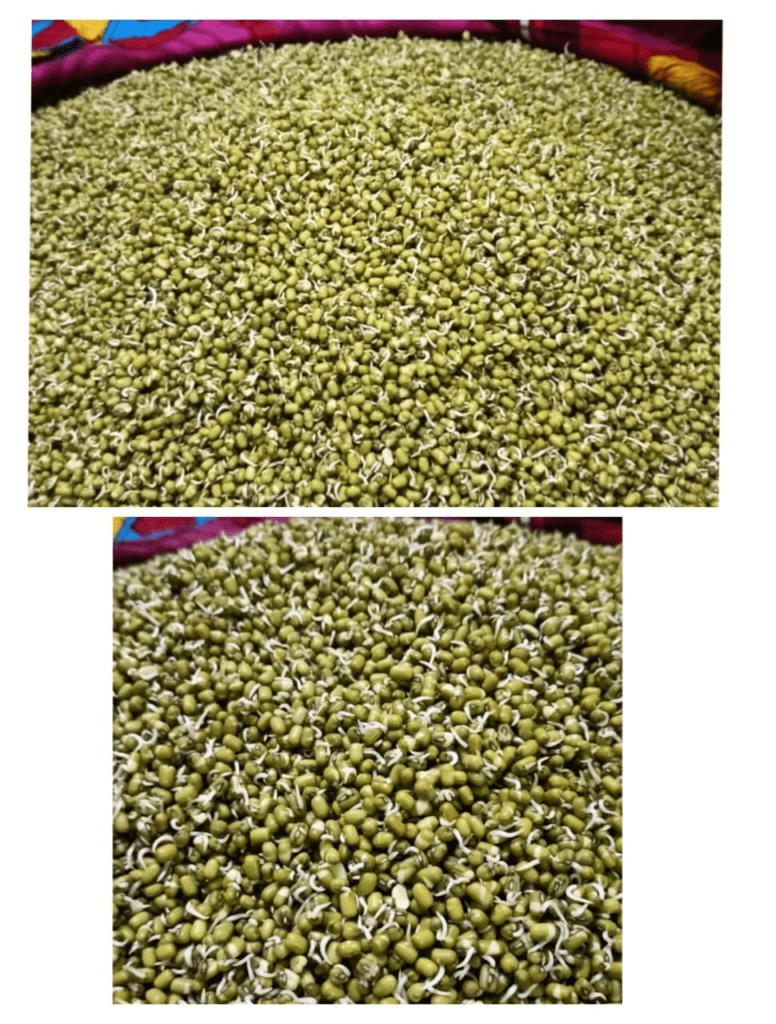
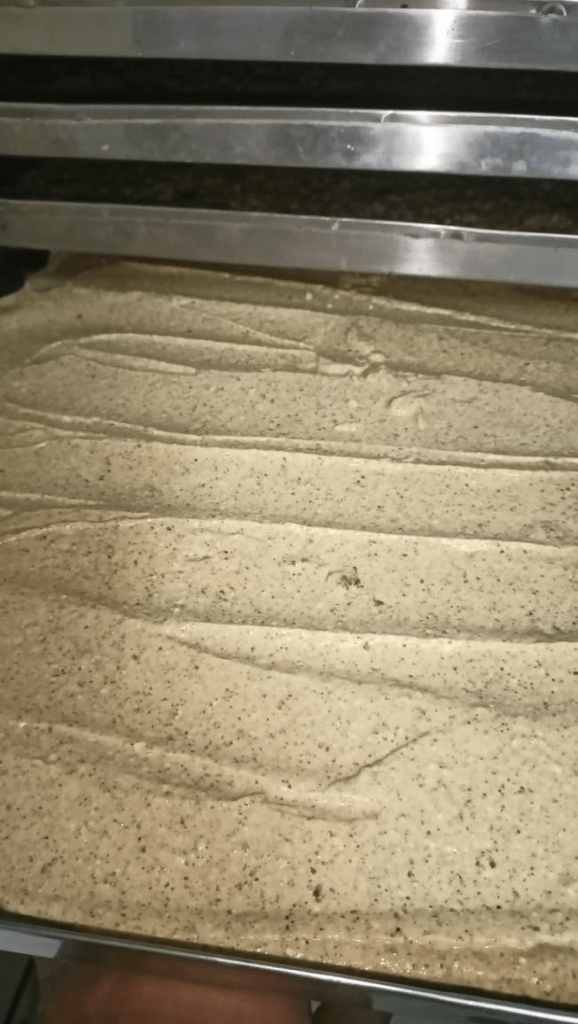
2. Costing Analysis
- Started detailed calculation of ingredient-wise costing to estimate the cost per bar.
- Included additional costs like:
- Processing & preparation
- Energy usage (heating, mixing, drying)
- Packaging materials
- Miscellaneous expenses (transport, storage)
- The aim is to determine a feasible selling price and analyze profit margin.
These the excel sheet for costing for making flours for these batch .
These excel sheet for protein ball
3. Packaging Material Selection
- Began exploring suitable packaging options to ensure:
- Good shelf life
- Attractive appearance for exhibition display
- Protection from moisture and breakage
- Considering laminated pouches and biodegradable wrappers for sustainable presentation.
- Also planned to design labels highlighting:
- Protein content
- Natural ingredients used
- Health benefits (high protein, fiber, prebiotic FOS)
05/10/2025 to 09/10/2025
1. Daily Trial Production (1 kg to 4 kg Batches)
- From 05/10/2025, I started preparing 1 kg batches per day, gradually increasing up to 4 kg total production.
- Each day’s batch was prepared with the finalized formulation containing FOS-L55, jaggery, and ghee for proper binding and taste.
- Focus was on maintaining uniform texture, proper mixing, and consistency across all batches.
- During this phase, I also checked:
- Batch-to-batch texture uniformity
- Binding performance at larger scale
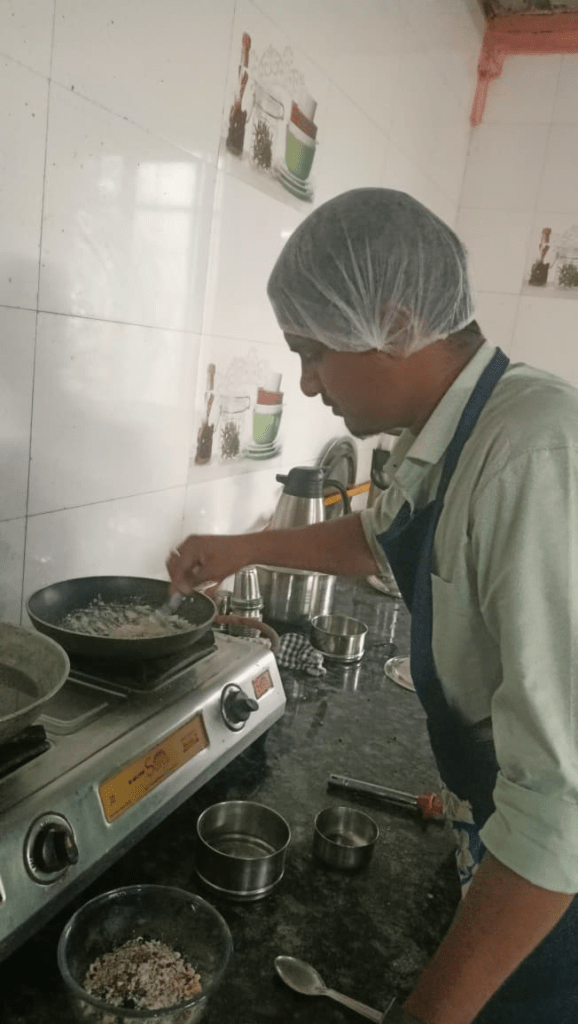
2. Sticker & Label Design
- Parallel to production, I designed an attractive product sticker for packaging.
- The sticker included:
- Product name and logo
- Ingredient highlights (soy, moong, yogurt mix, FOS-L55, jaggery, ghee, seeds)
- Nutritional value chart (per serving)
- Net weight and storage instructions
- Designed in both front and back layouts for professional presentation.


3. Nutritional Value Chart Preparation
- Based on earlier calculations, I finalized a nutritional value chart per 25 g serving, mentioning:
- Energy (kcal)
- Protein (g)
- Carbohydrate (g)
- Fat (g)
- Fiber (g)
- This chart was printed and added on the back side of the sticker for consumer information.

4. Final Packaging
- After completing all trials, I packed the prepared protein balls individually in foil paper to maintain freshness and hygiene.
- Later, all foil-wrapped balls were arranged and packed in display boxes for the upcoming Pune exhibition.
- The final packaging looked professional, neat, and market-ready, suitable for public presentation and sampling.
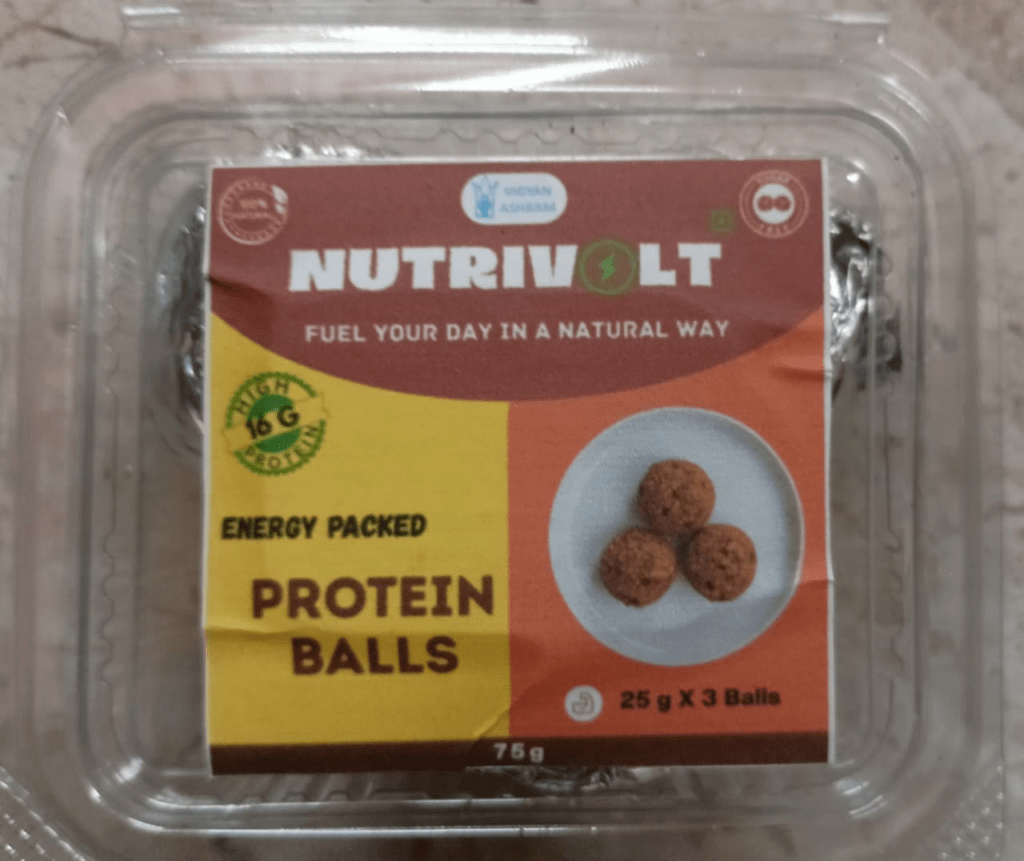
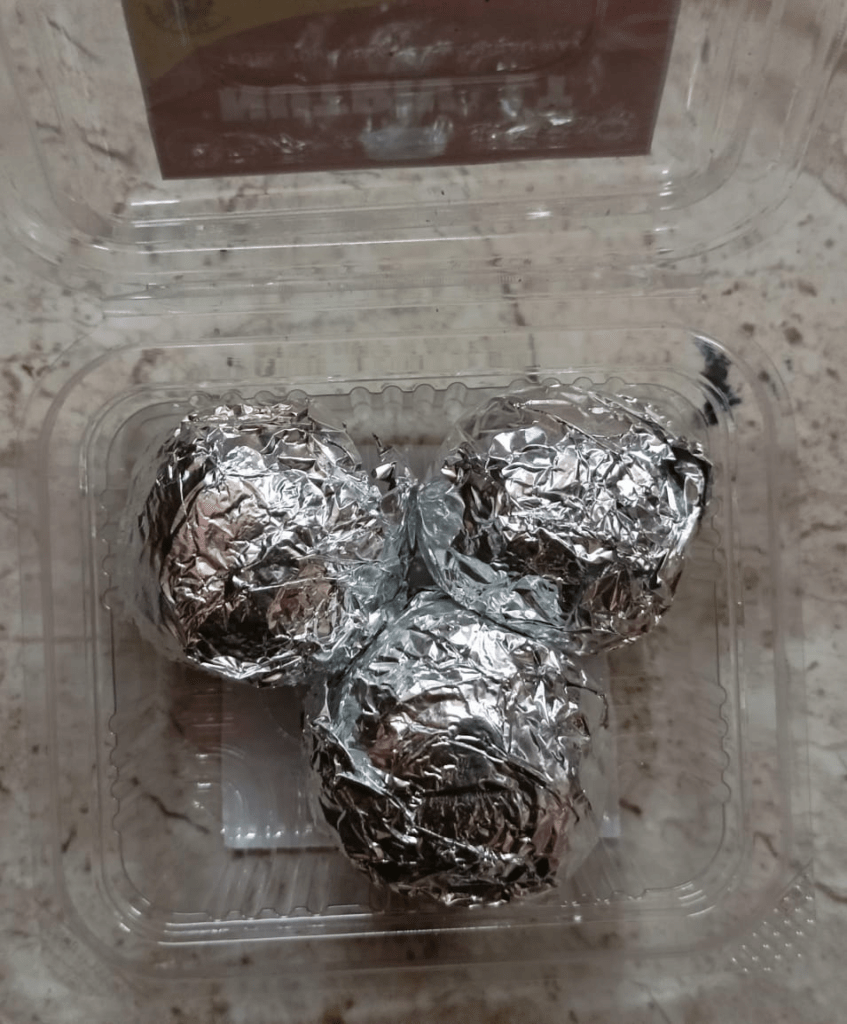
10/10/2025
On 10th October 2025, I had a detailed discussion with Dixit Sir regarding my previous protein ball trials and their outcomes.
During this meeting, I shared all my observations from the trials — including binding, texture, sweetness, and flavor response.
Discussion Highlights
In my earlier trials, I prepared three different flavor variations of the protein balls:
- Elaichi (Cardamom) Flavor
- Chocolate Flavor
- Vanilla Flavor
After evaluating all three, Dixit Sir appreciated the progress and provided the following feedback:
The Elaichi and Vanilla flavors were good but lacked the same level of aroma intensity and mouthfeel as the chocolate variant.
The Chocolate flavor had the best overall balance of taste, texture, and binding.
It gave a rich and appealing flavor profile suitable for consumers.
25/10/2025
Final Outcome of My Project: High-Protein Energy Balls
After several trials, discussions, and improvements in taste, texture, and binding, I successfully developed High-Protein Energy Balls that are nutritious, tasty, and easy to consume.
The product is made available in three delicious flavors — Cardamom (Elaichi), Chocolate, and Vanilla — each offering a unique taste and aroma.
Each 25 g serving (one protein ball) provides approximately 5.4 g of protein, making it a perfect mini-snack for students, fitness lovers, and health-conscious people. One box contains three protein balls (one of each flavor), delivering a total of about 16 g of protein per box.
The selling price of one box is ₹70, making it an affordable, nutritious, and ready-to-eat energy source that supports healthy snacking habits without compromising on taste.
This marks the successful completion of my project, transforming an initial idea into a practical and market-ready product that combines nutrition, taste, and innovation in every bite.
So for better understanding my work I make a report which include all information releted my project and how research and development is carried out
https://drive.google.com/file/d/1zEaY2uuuWFY0Rjzy5scOTVrUvAzZBJlR/view?usp=drivesdk



